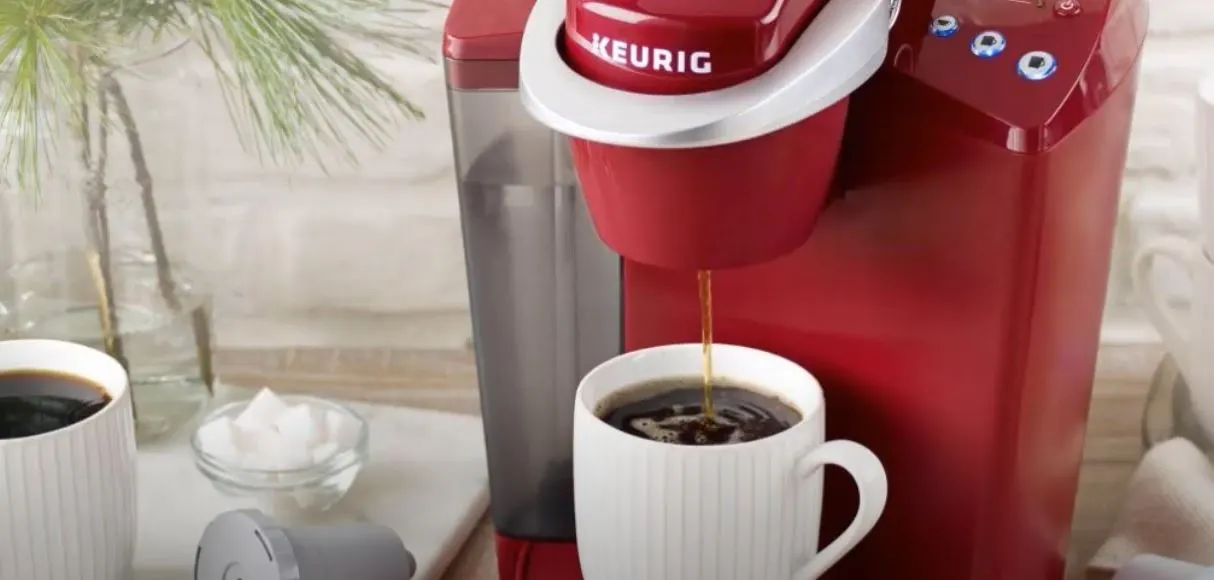Keurig brewers make some of the best coffees. Their brew is so addictive that a cup of coffee from Keurig becomes the first thing you need in the morning.
But how disappointing it would be that you expect a full cup of hot coffee and the brewer starts sputtering, giving off very little product.
Usually, Keurig fails to brew full cups when either its needles are clogged, the water levels in the reservoir are low, or the diaphragm below the tank is clogged. These issues can be easily solved with descaling sessions, proper maintenance, and some DIY techniques.
This article highlights all the possible reasons “Why is Keurig not brewing full cup?” Along with the potential causes, I have also enlisted some tips to help resolve these problems.
Table of Contents
ToggleWhy is My Keurig Not Brewing Full Cup?

If your Keurig fails to brew a full cup of coffee, it might be due to one of the following reasons;
1. Poor Maintenance
Poor maintenance might be one of the top reasons why your Keurig is not brewing a full cup. Over time, minerals (especially hard water) can build limescale in the brewer.
Scaling is like dirt to the brewer. It causes contamination, leading to a drop in the brewing quality. However, toxication is only one of the many consequences of scaling.
As the scale concentration increases, the situation worsens, and the brewer’s performance gets adversely affected. Eventually, limescale build-up puts a heavy load on the machine.
The machine cannot function appropriately. And besides degradation in quality, it ultimately fails to brew coffee up to the required quantity.
Fix: Run a Descaling Cycle
Your Kuerig may look clean and shiny from the outside. But you cannot expect it to remain the same from the inside.
The minerals from water accumulate into limescale and eventually lead to scaling.
Therefore, despite using it less frequently, you must descale your Keurig brewer every one to three months. To descale the brewer, you will require the descaling solution.
Since limescale is basic in nature, the descaling solution is acidic. It is primarily composed of citric acid. To learn how to run a descaling cycle, you can refer to the following video;
However, if the descaling solution is too expensive, you can try DIY lemon or white vinegar hacks. They work in a similar way to descaling solutions.
But before using these solutions for descaling, you must dilute them. White vinegar needs 50/50 dilution with water.
In contrast, lemon is slightly stronger and should be used in a 30/70 water ratio.
Keurig Descaling Light Won’t Turn Off After Descaling (How To Fix It?)
2. Clogged Needles
Your Keurig brewer has two needles, i.e., the entry and exit needle. The entry needles extract coffee grounds from the K-Cup. Whereas the exit needle pours brewed coffee into the mug.
But sometimes excessive use without upkeep cause clogging in the needles. Most people believe that a descaling cycle is sufficient to de-clog the needles. But it is not true.
Most of the time, the descaling fails to remove debris from the needles. Thus, the needles might remain plugged with debris or scale particles even after proper maintenance.
Clogged needles obstruct the flow of contents through the brewer. With restricted pathways, the needles fail to extract K-Cups properly and, thus, deliver lesser coffee than required.
Fix: Unclog the Entry/Exit Needles
Clogged needles should be immediately cleaned. Otherwise, the coffee maker would not be able to brew efficiently. To unclog needles, you can use a needle kit that comes with the brewer.
But if you don’t have the kit, you can also use a flat paper clip as an alternative. Using the paper clip instead of the needle kit is not straightforward.
One step is wrong, and you may damage the needle.
Observe the following method to learn how to properly use a paper clip for cleaning Keurig needles.
- Take a thin wire paper clip.
- Straighten out one end of the clip.
- Remove the needle cap from the entry/exit needle.
- Upon observing, you will notice a tiny hole in the needle.
- Now gently insert the clip inside the needle.
- Gently swirl the paper clip inside the needle.
- Continue the process until you ensure that the needle is clean from the inside.
3. Water Reservoir is Overflowing
Keurig brewers have a water reservoir that intensively affects the machine’s performance. This reservoir is often called “the tank” and is at the back of the machine.
The coffee maker also has a sensor in its computer that detects the tank’s water levels. If the water levels are too low or high, the machine won’t be able to brew coffee properly.
Thus, It is incredibly crucial for the reservoir to have ideal water levels. With higher water levels, the sensor will malfunction and brew lesser than the required coffee.
Fix: Drain Water from the Heating Component
If your reservoir is overflowing with water, you might face brewing problems. In this case, the best solution would be to draw a few cups of water from the heating component.
Another way to decrease water levels is to drain the reservoir. But that would cause you much hassle.
That is why I would personally recommend the first technique, as it is quick and uncomplicated.
4. Detached Water Brewer
Sometimes the water reservoir of the Keurig brewer may get detached. It happens when the brewer is shaken or shifted from one place to another.
When the brewer gets disassembled, the sensor stops working aptly. Consequently, it leads to distortions in the brewer.
In most cases, the machine fails to calculate how much coffee to brew. It would start wasting K-Cup grounds and provide half the amount of the required coffee.
Fix: Reconnect the Water Tank
If Keurig’s water reservoir is disconnected, you must re-attach it to restore the machine’s brewing quality.
But before reconnecting the tank, you should locate the tank’s position in the brewer.
The water tank’s position varies from model to model. In some Keurig brewers, the tank is quite approachable and is present at the front.
But in other Keurig models, the tank is at the back of the coffee maker. To reconnect the reservoir to the brewer, you must unscrew it first.
You can also consult the brewer’s user manual to clarify and simplify this process. Once re-joined, the sensor will start working correctly.
And you will witness an instant improvement in the brewing quality.
5. Faulty Brew Basket
All Keurig models have a built-in brew basket. It is primarily used to brew tea leaves and provide a freshly grounded blend.
But with time, the brew basket may wear out. And when it happens, the basket starts hampering the brewer’s performance.
One of the most significant signs of a faulty brew basket is that Keurig fails to brew a whole cup of coffee. It happens because a significant portion of coffee grounds clogs in the basket.
As a result, coffee grounds cannot reach the entry needle and get wasted. And with fewer ingredients, the brewer fails to produce the required amount of coffee.
Fix: Replace the Basket
Unfortunately, there is no alternative to a faulty brew basket. You must replace it when it goes bad.
All Keurig coffee makers have a one-year warranty. You should take maximum advantage of this benefit as long as possible.
Thus, the company will cover the replacement for free if your brew basket becomes defective within one year of purchase.
6. Obstructed Diaphragm Valve
The reservoir’s bottom part has a diaphragm pump. As suggested by its name, it pumps out debris from the water tank.
Moreover, it also maintains the water levels in the reservoir.
If they are too low, the pump elevates to raise the levels. But if the levels are already high, the pump increases the water flow to evacuate surplus water.
Like needles, debris, and limescale assimilate in the diaphragm with time. As the dirt particles clog the pump, the flow disrupts, ultimately affecting water levels.
As I mentioned earlier, water levels are integral to Keurig’s functioning. Keurig will not function aptly if the water levels are inaccurate, and its brewing capacity will diminish.
Fix: Clean the Diaphragm Valve
Cleaning the diaphragm valve is quite complicated. You must follow a systematic method to descale this pump. Otherwise, negligence could permanently damage the diaphragm.
- Start the process by removing the water reservoir from the brewer.
- Empty the reservoir by draining the remaining water.
- Now flip the reservoir to the other side.
- You will find a valve with a spring.
- Take a brush, some soap, and water.
- Scrub gently around the valve to extract the sum and dirt.
- Locate a tiny hole in the pump. You will need a toothbrush to clean this hole.
- Pat dry the valve and reassemble the coffee maker.
- Fill the reservoir with water and run the brewer to flush the residual.
Frequently Asked Questions (FAQs)
Why does my Keurig not give me a full cup?
If your Keurig is not brewing a full cup of coffee, it might be due to clogged needles, a damaged brew basket, an overflowing heat component, or a plugged diaphragm pump.
However, you can prevent these problems by running regular descaling cycles and maintaining the brewer.
How do you tell if your Keurig is clogged?
The foremost sign of a clogged Keurig is a drop in the brewing quality. When your coffee maker becomes clogged, you will immediately notice it is not brewing a full cup.
But you can resolve this issue by scrubbing the faulty area with soap and water.
Will Keurig work without descaling?
Descaling is very crucial for your brewer. This process removes limescale particles and mineral deposits.
Failure to conduct regular descaling sessions will adversely impact the brewing quality.
Author’s Takeaway
Once you have found out why is your Keurig not brewing full cups, you can start taking preventive measures. Proper maintenance and regular descaling sessions will help keep these problems at bay.
Keurig brewers make a great investment if you take care of them properly. Each Keurig model has different maintenance procedures.
Thus, for more specified instructions, you can consult their user manuals.






